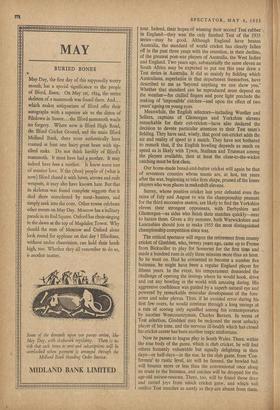Start of Play
BY JOHN ARLOTT THE first County Cricket Championship matches and the opening fixture of the South African touring team will begin this weekend. By the same date in 1930, Bradman was already 421 runs along his way to 'a thousand runs by the end of May.' Yet even after this degree of retreat before the footballers, first-class cricket's anxious treasurers must still face the competition of the Cup Final, with its sound and television broadcasts.
Those same treasurers, after their unhappy season of 1954, will welcome the South Africans with their reputation of bring- ing fine weather, memorably that eager sun of 1947 which lit Compton and Edrich to dancing rivers of runs.
No visiting party from South Africa has ever been regarded with such respect before it has even played a stroke on its oo tour. Indeed, their hopes of winning their second Test rubber in England—they won the only finished Test of the 1935 series—may be good. Although England have beaten Australia, the standard of world cricket has clearly fallen off in the past three years with the retention, in their decline, of the greatest post-war players of Australia, the West Indies and England. Two years ago, substantially the same eleven as South Africa may be expected to put out this year drew a • Test series in Australia. It did so mainly by fielding which Australians, superlative in that department themselves. have described to me as 'beyond anything we can show you.' Whether that standard can be reproduced must depend on the weather—for chilled fingers and poor light preclude the making of 'impossible' catches—and upon the effect of two years' ageing on young eyes.
Meanwhile, the English selectors—including Wooller and Sellars, captains of Glamorgan and Yorkshire elevens remarkable for their out-cricket—have also declared the decision to devote particular attention to their Test team's fielding. They have said, wisely, that good out-cricket adds the air and reality of speed to a match. They have not bothered to remark that, if the English bowling depends as much on speed as is likely with Tyson, Statham and Trueman among the players available, then at least the close-to-the-wicket catching must be first class.
Our home-made bread-and-butter cricket will again be that of seventeen counties whose teams arc, at last, ten years after the war, beginning to take firm shape, pruned of the lesser players who won places in makeshift elevens.
Surrey, whose positive cricket last year defeated even the rains of July and August to win the championship pennant for the third successive season, are likely to find the Yorkshire eleven their strongest opponents, with Derbyshire and Glamorgan—as sides who finish their matches quickly—near to harass them. Given a dry summer, both Warwickshire and Lancashire should join to make 1955 the most distinguished championship competition since war.











































 Previous page
Previous page